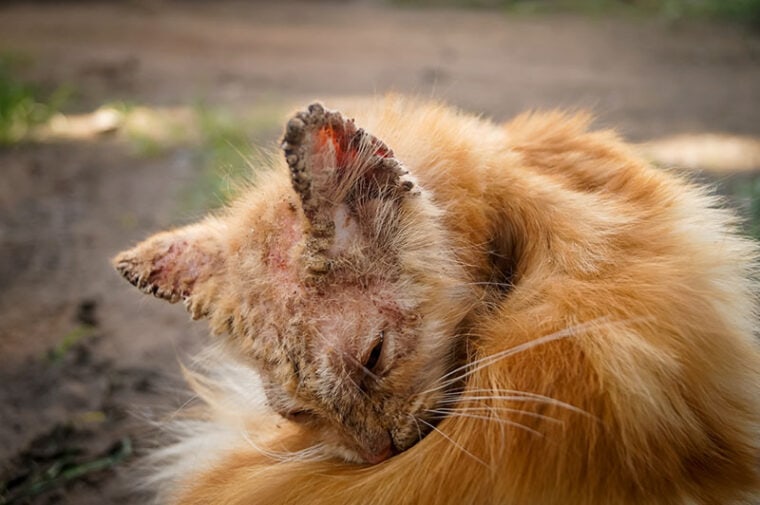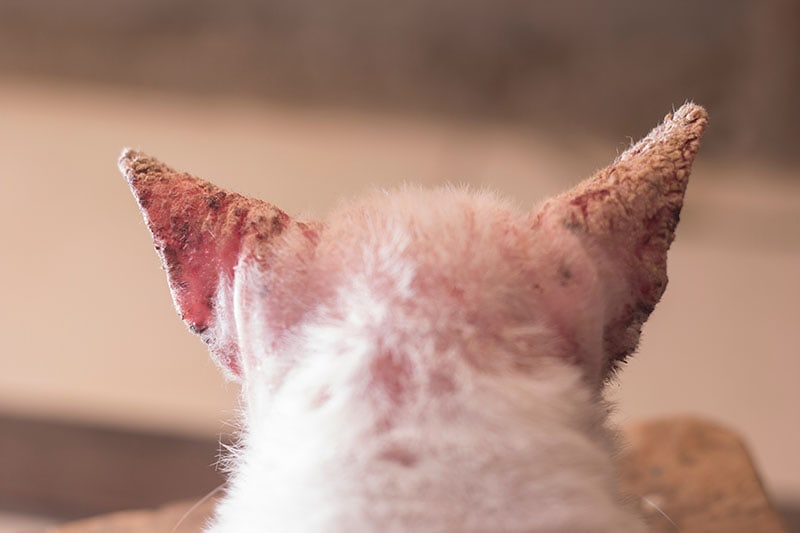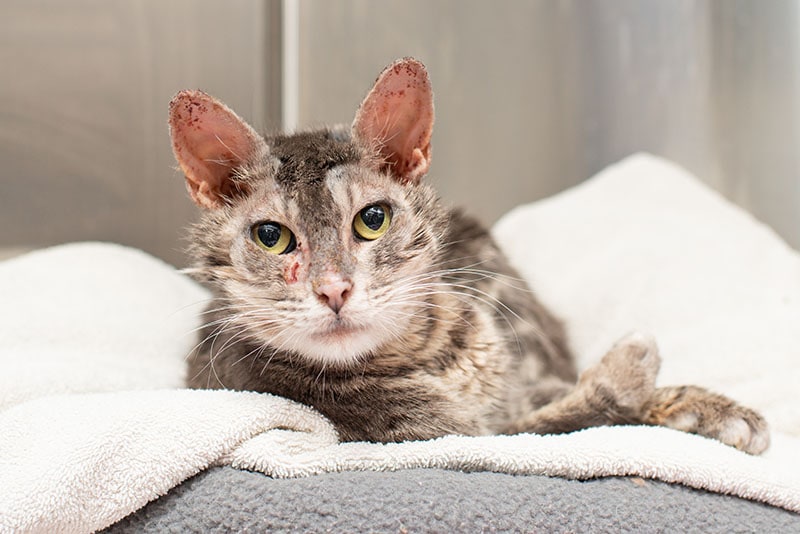
We all know that cats tend to be well-groomed and proud creatures, so it can be worrying when their full, shiny coat suddenly begins to look scaly and patchy. There are many causes of skin disease in cats, and demodectic mange is one that while relatively uncommon, can be particularly uncomfortable and sometimes signals an underlying health issue. For this reason, you should learn to recognize this disease so your cat can be appropriately treated.
What Is Demodectic Mange?
Several different types of mange can affect cats, and all are caused by parasitic mites. Mites are arthropods, not insects, which means they are related to ticks and spiders. However, unlike their larger cousins, mites are too small to be seen with the naked eye and require microscope magnification to visualize.
Demodex mites are more commonly seen in dogs than cats, and we have far more knowledge about the disease in dogs. However, awareness of demodectic mange in cats is on the rise, as they still make pests of themselves on our feline friends.

What Are the Causes and Signs of Demodectic Mange?
Two main mites are responsible for the disease in cats: Demodex cati and Demodex gatoi1. These are found in small numbers on the skin of all healthy animals, but disease happens when these mites multiply to abnormally high numbers. This is often the case when a cat has an underlying illness and their immune system is suppressed. Young cats with immature immune systems and older, more vulnerable cats are more prone to the disease too.
This table provides a general overview of the two mites and how they present clinically in cats.
| Demodex cati | Demodex gatoi | |
| Mite’s appearance | Long, slender | Short and stubby, no tail |
| Location | Lives deep in the skin, within the hair follicles | Superficial, lives in the outer layer of the skin |
| Contagious | No | Yes |
| Itchy | Sometimes | Yes |
| Hair loss | Around the head and neck | Around the flanks, legs, and stomach |
| Scaling/crusting | Yes | Yes |
| Found in the ears | Yes | No |
| Underlying disease | Yes | Sometimes but often seen in healthy cats |
| Diagnosis | Generally easy: skin scrapes and ear swabs |
Can be challenging because the mites exist in low numbers and are often licked off by the cat: skin scrapes and tape samples
|
| Treatment | Antiparasitic medication, such as Bravecto, Ivermectin, or milbemycin | Weekly dips in lime-sulfur |
Cats that have demodectic mange typically suffer from hair loss and crusting of the skin that may or may not be itchy. The hair loss may be spread across the entire body or be localized to just the head, neck, and ears. Sometimes, the skin may ulcerate, or develop small scabs. Occasionally, cats infected with Demodex gatoi may show no clinical signs at all.
How Do I Care for a Cat With Demodectic Mange?
Treatment of demodectic mange in cats depends on which species of the Demodex mite is involved. You must get a veterinary diagnosis so the appropriate option can be given. Treatment for cats with Demodex cati is subjectively simple and involves a veterinary-prescribed anti-parasitic medication, such as Bravecto, or oral doses of milbemycin or Ivermectin to kill the mites present on the cat’s body. It is often easier to put medication onto a cat’s skin than it is to give them tablets, so topical treatments that are applied in a small dose on the skin are generally preferred.
However, since Demodex cati often proliferates when the animal is immunosuppressed, the vet must rule out any underlying disease that could have resulted in a struggling immune system, such as diabetes mellitus, or feline leukemia virus. If the underlying illness goes untreated, the mites are more likely to persist or recur. If your cat is showing any signs of illness or even simple lifestyle alterations (such as drinking, urinating, and eating more), you should mention this to your veterinarian.

Demodex gatoi requires a different approach altogether, especially if you are in a multi-cat household. Since Demodex gatoi is contagious and sometimes asymptomatic, all cats in the household must receive treatment, even if they are not displaying signs of disease. This reduces the risk of one cat continuing to reinfect the others, which is frustrating for all parties involved.
Historically, this species can be more difficult to resolve than Demodex cati, and the current recommended treatment involves weekly dips or baths in a solution of 2% lime sulfur. The cat needs to be soaked in this dip for at least 5 minutes. Due to the smell (akin to rotten eggs!) and a cat’s general displeasure for bathing, these dips often require multiple hands and gentle restraint and are frequently performed in the veterinary hospital.
 Frequently Asked Questions (FAQs)
Frequently Asked Questions (FAQs)
Can humans catch demodectic mange from cats?
No, both Demodex cati and Demodex gatoi are species-specific. This means they cannot be passed from cats to humans or from cats to any other animals. However, Demodox gatoi can be passed between cats.
Will demodectic mange go away on its own?
Certain mild cases, where mange is localized to only a few areas on the body, can go away on its own if the underlying illness has been addressed and treated. However, more severe cases that involve large parts of the body require treatment, and infested cats usually respond quickly to appropriate management.
Can indoor cats get mange?
While uncommon, it is possible for indoor cats to get managed. The mites occupy even a healthy animal’s skin at low levels, so if a cat becomes immunocompromised, these mites could proliferate and lead to demodectic mange. There’s still much we need to learn about this condition in cats.
Conclusion
If your cat is showing signs of itchiness, hair loss, scaling, and ulceration, book a visit with your veterinarian. While there are several causes for these side effects aside from demodectic mange, such as allergies and ringworm, you should still get your cat looked at so they don’t inflict more damage to their body by the self-trauma of licking and scratching. It is also essential for any serious underlying illnesses to be ruled out.
Featured Image Credit: Suharji Esha, Shutterstock







